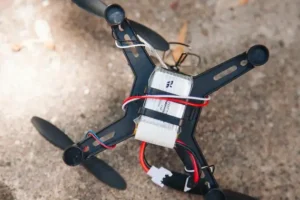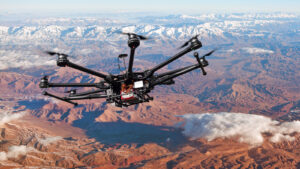Advancements in Drone Batteries
The use of drones has increased exponentially in recent years, and so has the demand for more efficient and reliable drone batteries. The development of new energy storage technologies has enabled drones to stay in the air for longer periods, fly farther distances, and carry heavier payloads. In this article, we will explore the advancements in drone batteries and energy storage, the challenges that come with it, and the future possibilities.
The importance of batteries in drone technology cannot be overstated. Drone batteries not only power the drone’s motors but also the onboard camera, sensors, and communication systems. The type of battery used can significantly impact the performance of the drone. For example, a drone with a lightweight battery can fly faster and longer than a drone with a heavy battery.
The earliest drone batteries were typically lithium-polymer (LiPo) batteries. LiPo batteries are lightweight and have a high energy density, which means they can store a lot of energy in a small space. However, LiPo batteries also have a limited lifespan and can be dangerous if not handled correctly. They are prone to overheating and can explode or catch fire if they are overcharged or punctured.

To address the shortcomings of LiPo batteries, researchers have been developing new battery technologies that are safer, more reliable, and more efficient. One such technology is lithium-ion (Li-ion) batteries. Li-ion batteries are more durable than LiPo batteries and have a longer lifespan. They are also less prone to overheating and are generally considered safer.
Another technology that has been gaining attention in recent years is solid-state batteries. Solid-state batteries use a solid electrolyte instead of a liquid or gel electrolyte used in Li-ion batteries. The solid electrolyte provides better stability and safety, making solid-state batteries more resistant to overheating, leakage, and other safety issues. They also have a higher energy density than Li-ion batteries, meaning they can store more energy in the same amount of space.
One of the challenges with drone batteries is their limited lifespan. The more a battery is used, the more it degrades, and the less energy it can store. This limits the range and flight time of the drone, making it less efficient. To address this challenge, researchers are developing new battery management systems (BMS) that can monitor and optimize battery performance. These BMS use algorithms and sensors to track the battery’s state of charge, temperature, and other parameters, allowing the drone to operate more efficiently and extend its battery life.
Another challenge with drone batteries is their weight. As mentioned earlier, the weight of the battery can significantly impact the drone’s performance. To reduce the weight of the battery, researchers are developing new materials and battery designs. For example, some researchers are exploring the use of graphene, a lightweight and highly conductive material, in battery electrodes. Graphene electrodes can store more energy than traditional electrodes, which could lead to lighter and more efficient batteries.
In addition to advancements in battery technology, there have also been developments in energy storage systems for drones. One such system is the use of fuel cells. Fuel cells use hydrogen or other fuels to generate electricity, which can be used to power a drone. Fuel cells have a high energy density and can provide longer flight times than traditional batteries. However, fuel cells are more complex and expensive than batteries, and they require a fuel source, which can be challenging to transport and store.
Another energy storage system that has been explored for drones is wireless power transfer (WPT). WPT uses electromagnetic fields to transfer power wirelessly from a charging station to the drone. This eliminates the need for physical connections, such as wires or plugs, and allows the drone to stay in the air indefinitely, as long as it is within range of the charging station. However, WPT is still in the early stages of development and has several limitations, such as efficiency losses, limited range, and the need for specialized infrastructure.
In addition to the advancements in battery and energy storage technologies, there have also been improvements in drone design and control systems. For example, drones are now being designed with aerodynamic features that reduce drag and increase efficiency, such as winglets and streamlined shapes. Control systems have also been improved, allowing for more precise and stable flight control, even in adverse weather conditions.
These advancements in drone technology have led to a wide range of applications, from aerial photography and cinematography to agriculture, search and rescue, and even package delivery. For example, drones equipped with high-resolution cameras and sensors can be used to monitor crops and detect pests or disease outbreaks, allowing farmers to take targeted action and increase crop yields. Drones can also be used to inspect and maintain infrastructure such as power lines, bridges, and buildings, reducing the need for costly and dangerous manual inspections.
As drone technology continues to evolve, the possibilities for their use are virtually limitless. However, there are still challenges that need to be addressed, such as safety, regulation, and privacy concerns. For example, drones can pose a safety risk if they collide with other aircraft or crash into people or property. There are also concerns about the use of drones for surveillance and invasion of privacy.
To address these concerns, governments around the world are implementing regulations that govern the use of drones. These regulations typically include restrictions on where drones can be flown, height limits, and requirements for certification and training for drone pilots. Additionally, there are efforts to develop technology that can detect and avoid other aircraft and objects, as well as systems that can identify and track drones.
The advancements in drone batteries and energy storage have not only improved the performance and capabilities of drones but have also made them more accessible to a wider range of users. In the past, drones were primarily used by the military and specialized industries, but now they are becoming more affordable and easier to use for consumers and small businesses. This has led to an explosion of interest in drones for recreational and commercial purposes, with millions of drones sold each year.
One of the key advantages of drones is their ability to access hard-to-reach areas, such as mountainous terrain or disaster zones. Drones can be equipped with sensors and cameras that can gather data and provide real-time information to first responders and emergency services. In recent years, drones have been used extensively in search and rescue operations, allowing rescuers to locate and reach victims quickly and safely. Drones have also been used to survey disaster areas and assess damage, enabling faster and more effective disaster response efforts.

In the commercial sector, drones are being used in a variety of industries, from construction and mining to logistics and transportation. For example, drones can be used to survey construction sites and monitor progress, reducing the need for manual inspections and improving safety. Drones can also be used to transport goods and supplies, particularly in hard-to-reach areas where traditional transportation methods are not feasible.
Another significant development in drone technology is the integration of artificial intelligence (AI) and machine learning (ML) algorithms. AI and ML can be used to improve the performance and efficiency of drones by enabling them to make decisions and perform tasks autonomously. For example, drones can be programmed to fly a predetermined route and collect data or perform specific tasks, such as inspecting infrastructure or monitoring wildlife populations.
In conclusion, the advancements in drone batteries and energy storage have revolutionized the drone industry, enabling drones to fly longer, farther, and carry heavier payloads. This has opened up new possibilities for their use in various industries, from agriculture and construction to search and rescue and disaster response. The integration of AI and ML algorithms has also improved the performance and efficiency of drones, enabling them to make decisions and perform tasks autonomously. However, there are still challenges that need to be addressed, such as safety, regulation, and privacy concerns. As the technology continues to evolve, it is important to balance innovation with safety and regulations to maximize the benefits of this exciting technology.










